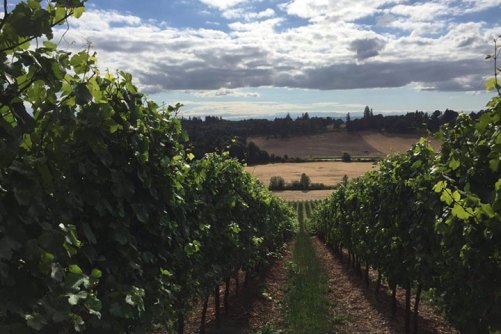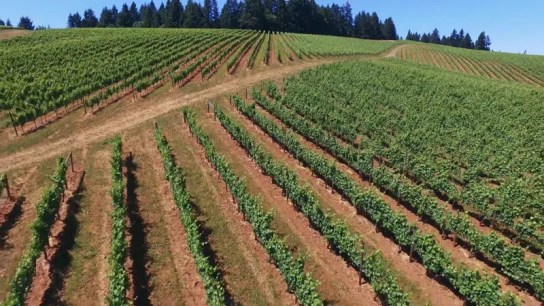What happens when you blend one of the country’s fastest-growing brands (hint: Acrobat) with the most popular white wine in America (hint: Chardonnay)?
You guessed it! Acrobat Chardonnay.
Produced by King Estate Winery in the southern Willamette Valley, Acrobat is for people who want a wine they can count on for any occasion. It is an effortless wine selection – not formal or fussy – made to enjoy with everyday life.
The brand debuted in 2009 with its 2008 Pinot Noir and 2008 Pinot Gris. The 2015 Acrobat Chardonnay is the first expansion to the line-up since the 2011 Rosé of Pinot Noir was added. Acrobat’s 2015 Pinot Gris was recently named the #1 Best Buy by Wine Enthusiast magazine (see related blogpost).
Most notable about this Chardonnay, and what sets it apart from its California counterparts, is that it is unoaked. This style is preferred by many Oregon producers, says Winemaker Spencer Spetnagel, perhaps in reaction to the perceived over-oaking of California Chardonnays.
“The Oregon style is more an expression of the grape as opposed to reflecting the winemaking process itself,” Spencer says.
Oregon Chardonnay is distinguished by its natural acid. (The three primary acids found in wine grapes are tartaric, malic and citric, with other acids produced in the course of winemaking.) When grapes are young they are primarily acidic with tough skins and bitter stems and seeds. This is Mother Nature’s way of protecting the seeds which aren’t yet ready for propagation. As the grapes ripen, sugar increases and acid levels drop off. The ripening grapes become visible and attractive to animals and birds who eat them and help spread the seeds. In making wine, the trick is to pick the grapes at the precise moment when the sugars and tannins are in perfect harmony.
The shift from acid to sugar in the grape is like a scale of justice with all the weights on one side, and slowly taking off one weight at a time and placing it on the other side. Eventually the balance tips. Grapes in the cooler Willamette Valley ripen more slowly than in more southern wine-growing regions, allowing time for sugars to form while retaining a nice amount of acid.
Winemakers often distinguish between two distinct ripening processes: phenolic ripeness and sugar ripeness. Sugar ripeness is what we normally think of with wine: acids breaking down and dissipating as sugars accumulate in the grape. Phenolic ripeness refers to the flavor and aroma of the grapes that comes from tannins in the skins, stems and seeds. Phenols – complex molecules that include tannins – are bitter and often described as astringent when the grapes are young. That bitterness gives way to a softer, sweeter taste as the fruit ripens.
When it comes to ripening, Oregon has the luxury of time. Phenols ripen more slowly than sugars. As we wait for sugar ripeness, we don’t need to worry about losing the phenols, or tannins. While the grapes sun themselves and store away evermore sugar, the tannins are still present, adding complexity and structure to the fruit. Here in the Willamette Valley, with our longer growing season, our grapes can reach their optimal sweetness without losing all that interesting tannic flavor and aroma.
Not so in hotter climates, where grapes ripen more quickly. There, because sugar ripeness is achieved early, growers tend to pick according to phenolic ripeness. The challenge in warmer regions is to reach the right level of phenolic ripeness before the grapes have amassed too much sugar – resulting in alcohol levels that are too high – while not losing too much acidity. Wait too long for the phenols to ripen and the wine will have too much alcohol and a “dead fruit” taste. Pick too soon and wine will taste bitter and overly tannic.
At Acrobat, our winemakers choose to showcase this beautifully balanced fruit by foregoing the oak barreling so popular in California. Fermenting in stainless steel rather than oak means the wine has less exposure to oxygen and doesn’t go through malolactic fermentation. One way to better understand what happens during malolactic fermentation is to analyze the word itself: malic comes from the Latin word for apple, and lactic from the Latin word for milk. Both acids are found in grapes.
In malolactic fermentation, bacteria that naturally occur in winemaking eat the malic acid, leaving the lactic acid. Malic acid is tart, like a green apple. Lactic acid is present in milk and in fact is sometimes called “milk acid.” The buttery flavor associated with Chardonnay comes from the lactic, or milky, acid that remains after Chardonnay undergoes malolactic fermentation in oak barrels.
Unoaked Chardonnay won’t have the same creamy, buttery mouthfeel we associate with the oaked Chardonnays of California and elsewhere. Instead, what you will notice when you first taste Acrobat Chardonnay is the fruit itself. Described as fruit-forward and linear on the palate, Acrobat Chardonnay is clean and straightforward. It stays in the middle of the tongue rather than rounding out to the cheeks to give that twinge or bite from the malic acid (the tart, green-apple effect) that is a hallmark of traditional California-style Chardonnay.
“Our Pinot Gris style has a lot in common with the Acrobat Chardonnay,” Spencer notes. “In both wines we showcase the fruit and balance it carefully with the natural acidity to provide a clean, layered taste with a lingering finish.”



